The Oregon Expressway: Residentialists Unite
In postwar America, the car was king. Having lived through tire rationing, rubber drives, and gas restrictions, “The Greatest Generation” had won the war and was ready to hit the road. Reemerging from wartime production plant conversion, the Motor City started working overtime, pushing out the automobiles that would soon become the beloved classics of a golden age of driving. And as Americans set out for the suburbs in the 1950s and began touring Eisenhower’s new Interstate Highway System in their ’57 Chevys and Ford Thunderbirds, governments were tempted to ram interstate highways through the maze of downtown streets in virtually every American city. City dwellers in tight-knit neighborhoods soon were dwarfed by towering super skyways and divided by six-lane highways barring them from their local grocer or library.
And, of course, highway building led to an endless cycle of further automobile dependence. As the new roads were built, more drivers took to their cars — purchasing cheaper homes farther from their jobs, making more shopping excursions to far-away malls, and partaking in the new “drive-in culture.” As new roads led to new drivers, new drivers led to new traffic. To which city planners often reacted by — you guessed it — building more roads.
It was in this context that Palo Alto fought its own car culture battle in 1961 and ‘62. While the near-freeway proposed by County planners on the site of old Oregon Avenue was just a mile and a half long — in a small city, this four-lane mega-road was symbolic of Palo Alto’s first steps towards bowing down to the dominance of the automobile.
There was certainly a logical basis for the political establishment’s desire to widen Oregon Avenue. As one of the crosstown streets that led from the newly upgraded Bayshore Freeway to El Camino Real — and perhaps more importantly — to the Stanford Industrial Park, the small two-lane residential street was continuously jammed. Studies done in the early ‘60s showed that traffic bottlenecked in at least three places on a daily basis. By March 1961, public support for a replacement sat comfortably above 70 percent.
But Santa Clara County’s original plan for what would replace Oregon Avenue struck many as a gargantuan horizontal swath that would effectively split the city in two. Additionally, the original plan called for the removal of some 107 homes in order to complete the $2.5 million widening project. The proposal would psychologically separate north and south Palo Alto with four bustling lanes divided by an austere chain fence and interrupted by just two cross streets — one at Middlefield and one at Louis Road.
A new movement of so-called residentialist opposition began to critique the plan in the local media and resistance soon reached such a fever pitch that the city council was moved to reject the plan outright. The county board was not pleased, later publicly reminding the Council of its “responsibility not only to a few citizens of Palo Alto, but to all the citizens of the county."
The council’s proposed replacement would prove far more appealing. It included a landscaped center median strip, six cross streets rather than two, eleven access roads, the removal of the divisive chain link fence, as well as a landscaped south side buffer and landscaped north side service road. Promises were also made to keep the speed limit under 30 miles per hour (although today the speed limit stands at 35). Such improvements even prompted one supporter to say that an “ugly-ducking freeway has changed into a swan of a parkway.” Still, even the modified version required the destruction of more than 90 homes and residentialist opposition remained fierce. So, as is typical with controversial matters in California, then and now, Palo Alto’s city council stuck it on the June ballot and let the voters decide.
The campaign was heated. A quick sampling of 1962 op-ed pieces in the Palo Alto Times shows just how bitter it was. For instance, Patricia Ford of David Avenue expressed the common sentiment that the expressway was just the beginning of the development: “One can only ask whether four or five years from now, when they see their once lovely foothills covered with industry and auto-exhaust haze, can it possibly be that once in a while what is good for Stanford is not necessarily good for Palo Alto.” Glenn Wayne of Middlefield Road lobbied against the “slums which are going to develop on both sides of that road” while other incensed residents railed against the forces they saw behind the construction. Councilman Bert Woodward Jr., for instance, told the Palo Alto Times that “this whole affair was generated by Stanford University, the Stanford Industrial Park, and the downtown merchants. These people still control Palo Alto and I think it’s unfortunate.” Miriam Patchen of Sierra Court wrote in “to say 'I told you so’ before the rape of Palo Alto.”
While the strongest words came from expressway opponents, there was ample support in favor of the expressway as well. On November 3, 1961, pro-expressway loyalists staged a public demonstration on Oregon Avenue to show how badly an expressway was needed. Cars were delayed over two hours when “The Traffic Action Committee and Residents of Oregon Avenue Improvement” parked more than 20 cars along the busiest stretch of the road with roof placards with slogans such as “This busy, narrow street is dangerous. Improve Oregon.”
The day before the vote the pro-Expressway forces were additionally aided by the endorsement of Mayor David Haight who issued a five-and-a-half page statement correcting “a variety of flagrant distortions of fact” and issuing a last-minute “no trucks on Oregon” pledge. On election day, the always fiery Councilman Robert Debs shot back that it was “highly improper” for a councilman to make such a statement at the “last moment with no chance of refutation.”
Perhaps it made the difference. The June 5, 1962 vote was extremely tight. While the anti-Expressway forces took a 100-vote lead based on large anti-expressway majorities in South Palo Alto, late evening votes coming in from the Walter Hays area put the expressway over the top. In the end, the road was approved by a razor-thin margin of 9,432 votes in favor to 9,030 opposed. Over the following year, houses were either moved or bulldozed, Oregon Avenue was torn up, and the new expressway was constructed.
Still, not all was lost for the residentialists. Despite defeat at the polls, the Oregon Expressway battle turned out to be the initial rallying call for what would eventually become a full-scale Palo Alto political movement. Buoyed by their united opposition, the residentialists would soon elect council members and take up other fights— eventually bringing down establishment mega-projects such as the Professorville hospital and downtown Superblock project. As Myron Chenard said of the residentialists shortly after the Oregon vote: “[We] are not folding up…there are going to be other fights and — I predict — other results.”
Today a drive down the Oregon Expressway conjures up a mixed legacy. While Palo Alto certainly paid its respects to the dominance of the automobile, its citizens were also early in recognizing the excesses of America’s car culture. Unlike many cities in America, local citizens acted in time to save the city from the monolith projects that might have been. And if Palo Altans must live with four-lane roads crossing their city, well, they could do a lot worse.
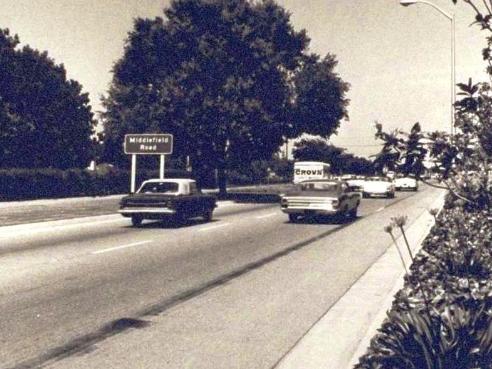
The Oregon Expressway, circa 1964. (Courtesy Palo Alto Historical Association)
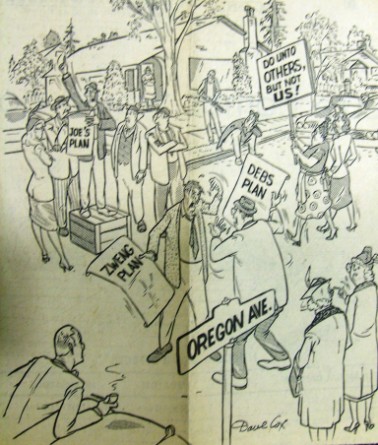
A Palo Alto Times cartoon depicting the many different plans for Oregon Avenue.
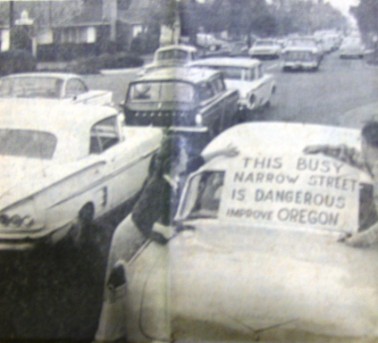
The sign on this parked car told passers-by why Oregon needed an improvement.
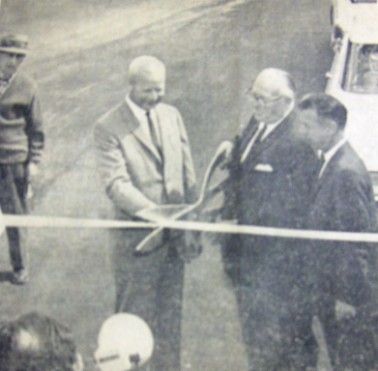
The opening of the Expressway.
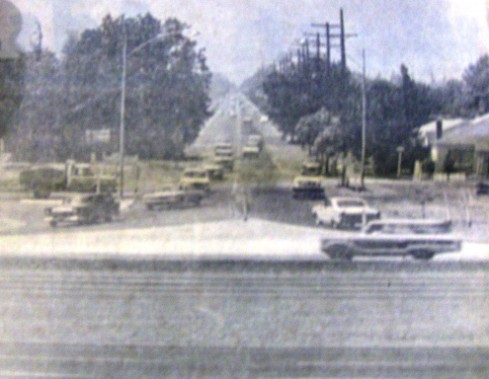
The old intersection at Oregon Avenue and Bayshore Road.